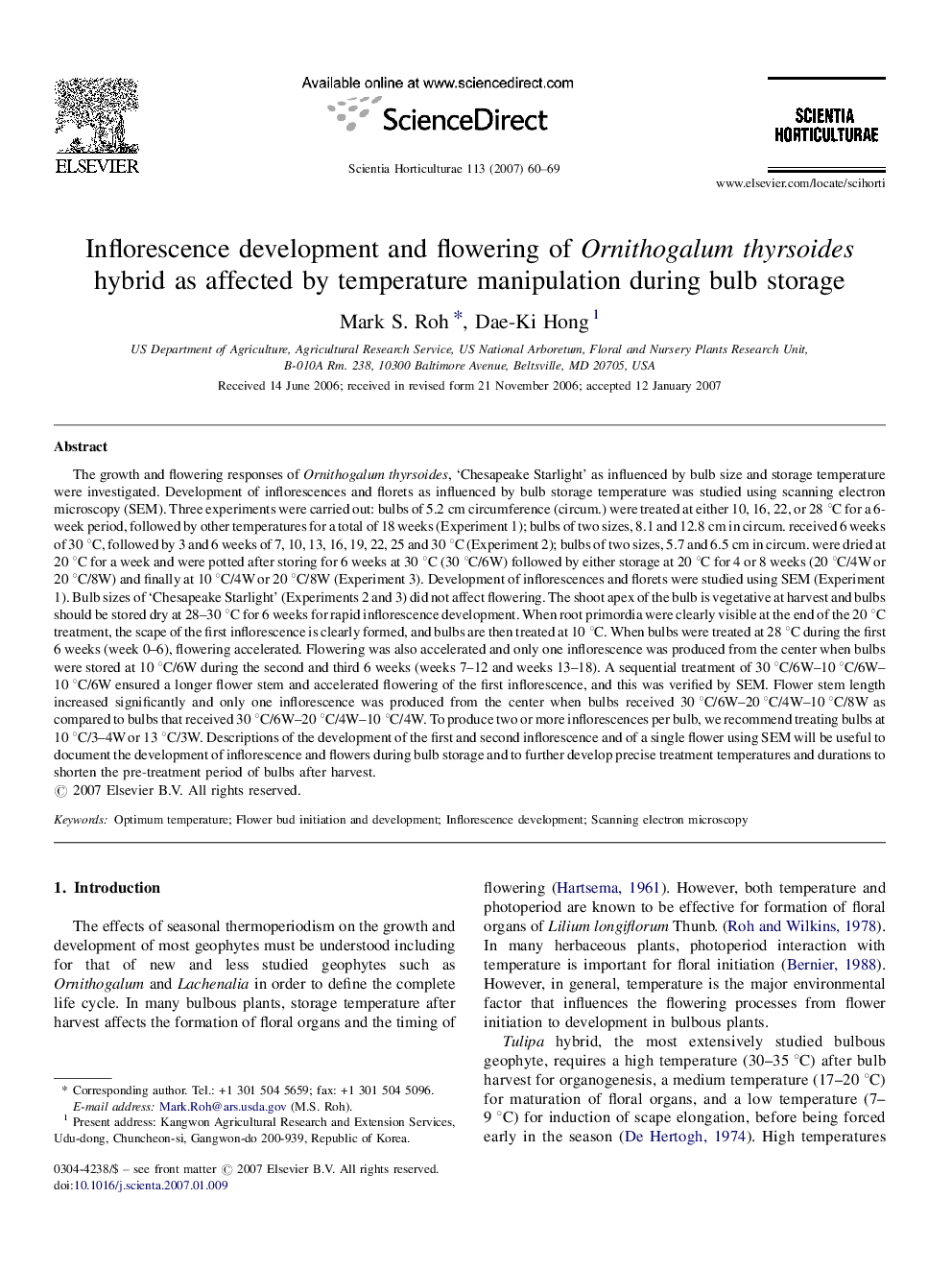| کد مقاله | کد نشریه | سال انتشار | مقاله انگلیسی | نسخه تمام متن |
|---|---|---|---|---|
| 4569703 | 1331351 | 2007 | 10 صفحه PDF | دانلود رایگان |

The growth and flowering responses of Ornithogalum thyrsoides, ‘Chesapeake Starlight’ as influenced by bulb size and storage temperature were investigated. Development of inflorescences and florets as influenced by bulb storage temperature was studied using scanning electron microscopy (SEM). Three experiments were carried out: bulbs of 5.2 cm circumference (circum.) were treated at either 10, 16, 22, or 28 °C for a 6-week period, followed by other temperatures for a total of 18 weeks (Experiment 1); bulbs of two sizes, 8.1 and 12.8 cm in circum. received 6 weeks of 30 °C, followed by 3 and 6 weeks of 7, 10, 13, 16, 19, 22, 25 and 30 °C (Experiment 2); bulbs of two sizes, 5.7 and 6.5 cm in circum. were dried at 20 °C for a week and were potted after storing for 6 weeks at 30 °C (30 °C/6W) followed by either storage at 20 °C for 4 or 8 weeks (20 °C/4W or 20 °C/8W) and finally at 10 °C/4W or 20 °C/8W (Experiment 3). Development of inflorescences and florets were studied using SEM (Experiment 1). Bulb sizes of ‘Chesapeake Starlight’ (Experiments 2 and 3) did not affect flowering. The shoot apex of the bulb is vegetative at harvest and bulbs should be stored dry at 28–30 °C for 6 weeks for rapid inflorescence development. When root primordia were clearly visible at the end of the 20 °C treatment, the scape of the first inflorescence is clearly formed, and bulbs are then treated at 10 °C. When bulbs were treated at 28 °C during the first 6 weeks (week 0–6), flowering accelerated. Flowering was also accelerated and only one inflorescence was produced from the center when bulbs were stored at 10 °C/6W during the second and third 6 weeks (weeks 7–12 and weeks 13–18). A sequential treatment of 30 °C/6W–10 °C/6W–10 °C/6W ensured a longer flower stem and accelerated flowering of the first inflorescence, and this was verified by SEM. Flower stem length increased significantly and only one inflorescence was produced from the center when bulbs received 30 °C/6W–20 °C/4W–10 °C/8W as compared to bulbs that received 30 °C/6W–20 °C/4W–10 °C/4W. To produce two or more inflorescences per bulb, we recommend treating bulbs at 10 °C/3–4W or 13 °C/3W. Descriptions of the development of the first and second inflorescence and of a single flower using SEM will be useful to document the development of inflorescence and flowers during bulb storage and to further develop precise treatment temperatures and durations to shorten the pre-treatment period of bulbs after harvest.
Journal: Scientia Horticulturae - Volume 113, Issue 1, 5 June 2007, Pages 60–69